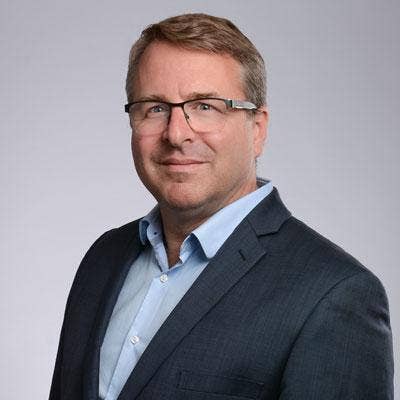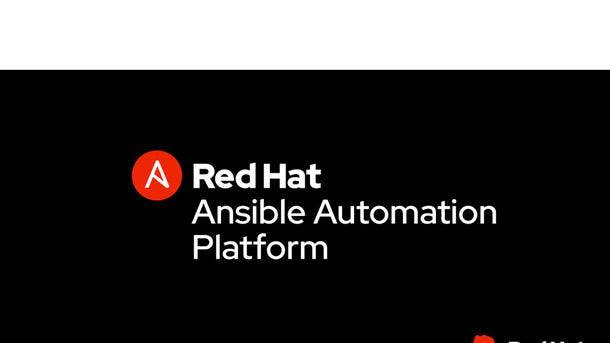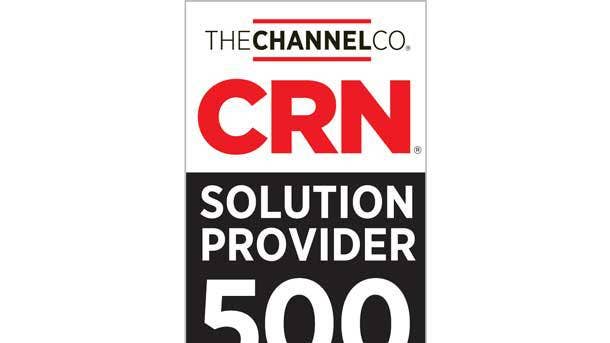Converge Technology CEO On Channel Consolidation, M&A And Private Equity
Converge Technology Solutions CEO Shaun Maine explains why vendors want channel consolidation, how private equity firms don’t understand solution provider M&A like Converge does, and his company’s plan to grow $1 billion in sales per year.

Red-Hot CEO Shaun Maine: The State Of The Channel In 2022
Shaun Maine, CEO of one of the fastest-growing channel partners in the world, understands what mid-market customers need from the channel in 2022 and how to partner best with vendors as they push for more channel consolidation.
“Mid-market customers can buy hardware from anyone but moving those workloads to the cloud—that is what they desperately need. Large enterprises have specialists for that and it’s all about cost to them, but mid-market customers are like, ‘Please help me!’” said Maine, CEO of Converge Technology Solutions, who has acquired 27 channel partners over the past five years.
Maine said Converge Technology Solutions’ successful acquisitions strategy and growing skillsets is what vendors are looking for which is helping to fuel vendor-funded campaigns around winning new customers in the multi-cloud era.
“We are a growth partner in the mid-market which is a segment that the OEMs don’t do very much in. They sell direct to the Fortune 500 really well but they don’t do mid-market very well. This is where we really can help them out,” said Maine.
Converge Technology Solutions has transformed itself via dozens of acquisitions and successful integrations that enable massive cross-selling opportunities. The solution provider prides itself in its different approach to channel M&A compared to the large private equity and financial firms currently pouring millions into the channel.
“The whole strength of what we do is our people and customer relationships. Sometimes financial players come in from the outside and try to buy these companies, and they blow them up, because they don’t understand how important those relationships are,” said Maine.
The Canadian company has climbed from No. 450 on CRN’s Solution Provider 500 list in 2017 to ranking No. 39 on the 2021 Solution Provider 500.
In an interview with CRN, Maine talks about why vendors want channel consolidation, private equity firms channel investment strategy and Converge Technology Solutions’ plan to grow $1 billion in sales per year.

Private equity is pouring money into the channel but isn’t able to grow solution providers like you can. How does Converge do M&A better than the private equity firms?
So they don’t really get the leverage from the vendors. Really what the vendors are looking for and why they want us to consolidate the channel, is because, [let’s say] we have a telemedicine solution in a children’s hospital in Atlanta with Cisco. Every single NFL city has a children’s hospital and they’d like to partner with someone that can roll those out nationally. But in order to do that, you have to have a structure that allows you to have regional engineering teams, regional sales team and cross-selling offerings.
At my former company Pivot, we got it wrong. We didn’t learn how to integrate, especially cross-sell the offerings. This is what our President Greg Berard has been so brilliant at is around these practice areas and the pre-sales architects in the regions.
When we buy companies, the salespeople report regionally. Like Dasher had salespeople in the southeast. Well, they now reported to that local structure. So getting that right is important because the vendors want to engage you on local campaigns. So if you don’t fit into that, then well, do they care when you’re talking to them? So it’s about understanding the vendors.

Do vendors want the channel to consolidate?
Of course they do. It’s too much work for them. Like say they want to roll out campaigns. It’s much more work for them to talk to 25 [partners] as it is to one. So if we can roll it out to all their major markets, that’s a good campaign for them.
A lot of the campaigns are regional, which I get, but like how we did this [Red Hat] Ansible campaign—that’s a North American campaign. We go city to city, and it’s the same campaign that really works. We grew our Red Hat sales by 100 percent last year.
So the campaign is working and we’re getting net new logos and new people by having them come to you for these workshops. That engagement model works. A lot of the companies we buy have never sold Red Hat before. And yet now, they’re able to leverage our Red Hat practice across all the companies.
Because otherwise, think about the engagement model from Red Hat. They have to talk to all these different partners. Is it consistent? Is it not? Are their customers getting the right user experience?
A lot of times market development funds, the whole reason the vendor is giving it to you is to grow sales. Some smaller companies, they say they’re using it [for MDF] but they’re actually just putting it into the bottom line. So vendors want to be able to trust a partner. And they see it in the results, it’s all about sales growth.
If you look at the awards we win at all the vendors conferences—like our Red Hat Partner of the Year, Analytics Partner of the Year, Cloud Partner of the Year—this is because we are a growth partner in the mid-market, which is a segment that the OEMs don’t do very much in. They sell direct to the Fortune 500 really well, but they don’t do mid-market very well. This is where we really can help them out.

It’s very costly today for partners to get trained and certified, which makes it hard for a partner to make a profit. Why is it so costly to be a channel partner in 2022?
The reason it’s so expensive to get these certifications is vendors want to ensure that their customers are getting the right user experience. Unfortunately, a small player can’t do it.
So what the small players do is they have a couple engineers that become, basically, professors. They take all the tests in the corner—that is not what the vendors intended, right? The vendors intended for you to have trained people engaging with your customers, not writing exams so you can get more rebates. If you understand what the point of it all is, it’s all about the user experience.
[Vendors] want to hear about our client engagements. They want to make sure that we are delivering for their brand as well with the right user experience around these high-end solutions. So yes, it does take a lot of investment in order to get there. Unless you’re going to be able to scale that investment to a large customer base, then yes, it’s really hard for a smaller partner.

How are you winning 100 new logos per quarter? What’s one good customer growth strategy that’s working for Converge?
What we’ve been really good about doing is running campaigns. So with Red Hat, in particular, we run these campaigns that are funded by Red Hat, where we will go city to city and we’ll hold workshops for free for mid-market customers. So mid-market customers come to us to learn how to use Ansible, Red Hat’s management platform. That’s such a better way of getting net new logos. We have about 100 net new logos a quarter.
It’s effective to have your technical people say, ‘Hey, here’s how you use Ansible. Here’s how you use OpenShift.’ That way, customers can kind of kick the tires and learn about these new technologies. So there is a different way of partnering with the vendor. Because the reason why vendors fund these things is because they’re expecting a return on their investment.
It’s very efficient when we buy a company in a new NFL city, then we just add them to the schedule for these Red Hat workshops on Ansible, for example. It’s pretty efficient when you bring 30 customers in for a one-day workshop, rather than having a salesperson and engineer going around to all these customers as you would with a large enterprise.
So we’re very much mid-market focused, which can get quite large like 500 to 10,000 seats, but there’s new ways of engagements in order to showcase these new technologies.

How are you growing so fast in the mid-market?
Large enterprises don’t need any help getting to the cloud, but mid-market customers in technology, in finance, in healthcare, in education—they do. Why we created Converge was, ‘Let’s go buy this national platform in North America. Then hit all the NFL cities.’ Because channel partners want to partner on a local service level. These smaller companies are competing on technology and service levels because they weren’t the big guys. Like the CDWs had the best pricing, so they had to do something else.
Small channel partners, they can’t afford things like data scientists. Small channel partners can’t afford things like data scientists. They can’t afford the cybersecurity people. These are skillsets that smaller partners are discovering they really need, so they need to be part of something bigger. Now, we’ve got a fantastic analytics practice. We bought CarpeDatum, LPA [Software Solutions] and Essextec Technology Group that has 85 data scientists, it’s one of the best analytics practices.
For the next three years, we’re going to buy $1 billion of revenue in the channel: $400 million in North America, $400 million euros in Europe—per year. We were around four to six [acquisitions] per year in North America and that we’re adding four to six [acquisitions] a year in Europe. So you’ll you should see this pace maintain itself the next few years.

Why is cloud disrupting the channel so much on multiple fronts including many seeking capital from private equity firms?
The whole reason that the channel is so interesting is because of cloud growth rates. Back in the old days, VARs used to grow at GDP growth rates. So if you sell data center equipment, you’re growing at low single digits. All of a sudden the cloud enters and there’s this potential for fantastic growth rates with these people with great customer relationships.
The problem the VARs have is, they’ve been there 20 to 25 years with great customer relationships. But it’s really expensive to have a practice around analytics, and cybersecurity, and cloud, managed services—and they need the cloud provider practices as well: so an AWS practice, a GCP [Google Cloud Platform] practice, etc. When we buy partners, they can now have so many more things to sell into their customer base. What we are seeing is they’re having to introduce other competitors into their accounts because they don’t offer those things.
Because we’re from the channel, a lot of VARs know us. We’re not the financial players from the outside. Our chairman of the board is Thomas Volk. He used to be the CEO of Cancom, which was a partner in Germany, but before that, he ran worldwide sales for Hewlett Packard. He ran Europe for Dell. Our president [Greg Berard] came out of the IBM ecosystem.
We always tell her our targets, ‘talk to all of the companies that we’ve acquired.’ Because the one thing about the channel is, we’re a people business. The whole strength of what we do is our people and customer relationships.
Sometimes financial players come in from the outside and try to buy these companies, and they blow them up, because they don’t understand how important those relationships are. Although it’s a big industry, it’s also very small industry, right? So everybody knows everyone. Like, all your vendor partners, they’ve just moved from vendor to vendor—it’s all the same people.
We’ve been buying up smaller companies because they have big market customer bases. And we’re helping them move to the cloud.

What does private equity and financial firms do wrong?
A lot of these financial guys come in and they say, ‘Oh let’s reduce commissions.’ No, have your salespeople make more money by selling more things.
What [financial organizations] are doing is spreadsheet. What we’re doing is understanding our vendors and what they’re trying to achieve. How do we link up to what are vendors trying to achieve with what our customers are trying to achieve, and understanding what changes they need.
[We tell them things like] VMware and Red Hat are important because these Kubernetes containers are helping move workloads to the cloud. So once they’re in the cloud, they can move them. Like, that’s the new operating system hybrid IT. I don’t know if a private equity shop gets that. They’re do lots of diligence on what you’ve done before, but we are not doing the same thing as before—we’re always changing.
Also, when you buy mid-market companies, it’s very different on how you integrate them. The PE playbook is very different than our playbook on things like ERP systems. We cross-sell first and integrate later. That [strategy] is like swearing to PE firms. … So we add the value first and then automate the system so you can share resources and case studies and all the rest of it. So we do things differently than private equity.
We also live a lot faster and we know these companies so well. Private equity is like, ‘Hello. Pleased to meet you.’ And we’re like, ‘Hey! I’ve seen you the last 25 years at all the vendor conferences and probably in a bar or two maybe. We’ve all hung around for a long time together.’ So these are all people we know. … These partners we acquired are also telling their friends, ‘Hey, this has worked out really well.’ That’s part of the reason why we’ve had 27 companies join the family so far.

How large of a growth opportunity is the mid-market around cloud?
Microsoft CEO Satya Nadella (pictured) talks about 55 percent of workloads being cloud-based by the end this year—he’s talking about large enterprises. The mid-market is left behind. … Mid-market customers can buy hardware from anyone, but moving those workloads to the cloud—that is what they desperately need. Large enterprises have specialists for that and it’s all about cost to them, but mid-market customers are like, ‘Please help me!”
I’m not aware of anyone else but us that has data scientists in the mid-market. Everyone goes after the large enterprise like, ‘I want my Fortune 500 accounts.’ We don’t. Mid-market companies are using their own IT staffs to struggle with these things of, ‘How do I move to the cloud?’ And they’re not well equipped with, ‘What’s the latest and greatest? How do I implement Kubernetes containers? Who are the market leaders? Where do I put my workloads? What’s best for me?’ That’s not what they’ve been trained to do. So they need help. The internal IT organizations if mid-market customers, they can buy hardware from anyone, but moving those workloads to the cloud—that’s what they desperately need. You need to be there with those right skillsets.
If you had to build an 85 person data scientist team from scratch—that would be very hard. So if you can be bought by Converge, and then we’ll cross-sell our analytics practice—which is one of the richest ones in North America into your customer base— then your salespeople are making more money.

What is Converged M&A strategy for the rest of the year?
In 2022, I’m going to be buying between eight and 12 companies combined between North American and Europe. It will be four to six [acquisitions] a year in North America, and four to six [acquisitions] in Europe.
So $1 billion of revenue is our target this year, it will probably be north of that. There are some fantastic companies that are ready to become part of the family. Our goal is $1 billion in new revenue, per year, for the next three years. So we’ve got great pipelines of, per year, $1 billion of new revenue by buying companies.
We’re very well capitalized. I raised $640 million in the last 18 months in the public markets because people saw us executing this strategy and they saw how we work.
This is a better way of growing. Some people try to grow by hiring salespeople or training them up as new grads, I would rather buy people with great customer relationships and cross-sell. We grow organically through the cross-sell, but no one can compete with my growth rate when I can buy the way I buy companies with the way I grow companies.
Is there any common theme that you’re looking for?
Customers. It’s about wonderful mid-market customers in health care, in education, in finance and technology. It’s about having a diversified customer base. We don’t buy people with concentrated customer bases [around a few large customers], that’s not what we’re looking for. Wonderful mid-market customer bases that we can help their customers move to the cloud.

How does your acquisition and follow-up integration strategy work? How does Converge make dozens of companies work together?
In 2017, I went through the CRN Solution Provider 500 list. I went through all the companies between $75 and $200 million in sales. Because we all know each other and we all hang out at the vendor conferences, I ranked them by culture-first, then by customer, then geography, and then capabilities.
But culture is really the most important thing. Smaller companies have this younger and funner culture. Our values are integrity, number one—because if I shake your hand, I mean it. Number two is work hard and play hard. Your channel people understand that. More deals get done on a golf course or in a bar than they do in a boardroom. We spend so much time together that you better enjoy each other’s company. That’s our culture. And winnings our third value. We have fun and we hang out together. So we are personal people that understand our clients and our customers problems. They don’t talk about the problems in the boardroom.
Especially during the pandemic, we find a way to get it done. Some companies were dear in the headlights, but the nimble, the small, the local [survived]—and that’s what we want to do is: be large, but act local. We’re about getting that combination right.
We never change brand or comp plan the first year. We make sure the salespeople make more money. We make sure the customers know that they’re still being serviced the same way it was before.